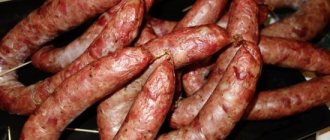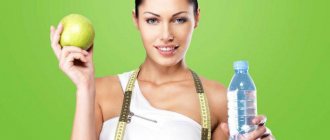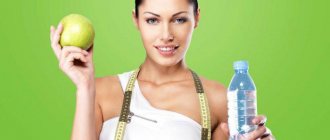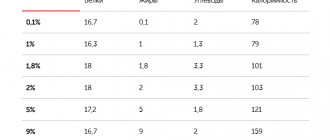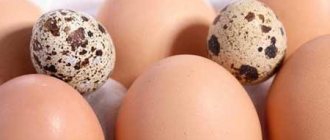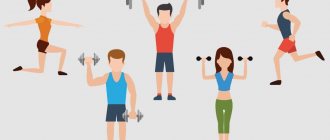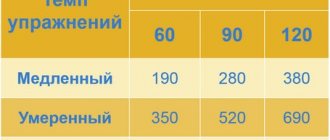BZHU and KBZHU banana per 100 grams
Before introducing a product into the diet, it is necessary to evaluate the nutritional value. They will be different.
Ripe banana KBZHU (with peel):
- proteins – 0.91 g;
- fats – 0.30 g;
- carbohydrates – 12.71 g (91.3%);
- calorie content – 58.12 kilocalories.
Ripe banana BZHU (without peel):
- proteins – 1.44 g;
- fats – 0.42 g;
- carbohydrates – 26.61 g (92.1%);
- calorie content – 93.33 kilocalories.
But since the peel is not used for food, when compiling a dietary diet, the CBJU in a banana without peel is taken as a basis, i.e. only pulp.
When considering how much protein is contained in a banana, you need to take the fruit without the peel as a basis. Although the latter does not play a special role. In both cases, the protein content is minimal - 0.91 g and 1.44 g.
If we talk about how much fat is present in banana pulp, then a ripe fruit without peel “offers” only 0.42 g of the substance per 100 g of product. The figure is less than 1% of the daily value. Most banana fats are saturated, but there are also polyunsaturated and monounsaturated fats.
When calculating how many carbohydrates are in a banana (in 1 piece), remember that the average figure is 30.7 - 32 g.
Answering the question of what is more in a banana: proteins, fats or carbohydrates per 100 grams of fruit, sugars predominate in the composition of the fruit.
Chemical composition of banana
What else is included in the product? After all, monosaccharides and polysaccharides are not the most important components in the pulp. So, the entire chemical composition is given in the table.
| Component | gram in 1 piece | Grams in 100 grams of banana |
| Carbohydrates | 32 | 28 |
| Fats | 0,27 | 0,2 |
| Protein | 2,2 | 1,6 |
| Calories | 130 | 100 |
| Cellulose | 2,4 | 1,7 |
| Potassium | 391 | 346 |
| Magnesium | 49 | 41 |
| Sodium | 41 | 32 |
| Phosphorus | 40 | 27 |
| Manganese | 0,38 | 0,28 |
| Calcium | 11 | 8 |
| Zinc | 0,29 | 0,16 |
| Selenium | 1.9 mcg | 1 mcg |
| Iron | 1,1 | 0,7 |
Are bananas fast or slow carbohydrates?
When understanding what kind of carbohydrates are in a fruit - fast or slow - you need to understand what each of the varieties of the latter represents.
Fast (simple) - monosaccharides. Represented by sucrose, fructose and glucose. They are quickly absorbed by the body, satiate and provide energy. They do not act for long, so the feeling of hunger occurs quickly.
Slow (complex) - polysaccharides that take a long time to be absorbed by the body. These are glycogen, fiber and starch. Do not cause a sharp increase in blood sugar. Gives a long-lasting feeling of satiety.
If we consider what carbohydrates are contained in a banana, the pulp offers both varieties. If hypoglycemia develops (a sharp decrease in blood sugar levels), the fruit will help correct the situation, since more than 90% of the carbohydrates contained in the pulp belong to the group of monosaccharides.
But, despite the minimal amount of polysaccharides (10%), banana can be used in dietary nutrition due to its high fiber content. Fiber ensures a long-lasting feeling of fullness.
Are you having trouble losing weight?
Answer 8 questions and find out why you can't lose weight.
Test for women
Test for men
What are the benefits of banana carbohydrates?
Considering the entire chemical composition of the fruit, the fruit is very beneficial for the body as a whole. The exotic product is considered a source of vitamin B. These components, in combination with polysaccharides, ensure the normal functioning of the central nervous system and the digestive system. Also, banana is the main source of protein.
Polysaccharides for digestion
Bananas have a low glycemic index, despite all the sweetness of the pulp. Thus, insulin production occurs systematically, without excessive release. Fiber and dietary fiber normalize the process of breakdown and digestion of food and improve intestinal motility. Nutritionists advise replacing sweets with 1-2 bananas a day. This way you can lose weight without harming your body.
In general, the polysaccharides in this fruit provide the following benefits:
Beneficial features
Knowing how many grams of protein, carbohydrates, fats and other nutrients are in a banana, it’s easier to build a diet. At the same time, the fruit has a number of useful qualities:
- 1-2 pieces are enough to improve your well-being.
- The beneficial elements contained in the product improve mood, increase tone, help concentrate attention and performance.
- Supplementing your diet with bananas is useful for athletes who care about increasing muscle mass.
- The product is useful for patients with atherosclerosis and hypertension. It is recommended on fasting days and is in demand due to the presence of potassium and magnesium in its composition.
- It perfectly helps in the treatment of diseases such as nephritis, liver diseases, stomatitis and others.
- The juice of the fruit also has healing qualities. It contains many useful elements that help with cholera, dysentery, and hemorrhages.
- The protein in banana is a plus for people who are protein deficient.
- Taking the fruit is recommended for rashes, migraines, hysteria, epilepsy, allergies, diabetic ulcers and other problems.
Health Benefits of Bananas
Bananas have a number of health benefits.
We offer you: Rambutan fruit: nutrition, health benefits and how to eat it
Heart Health
Heart disease is the most common cause of premature death in the world.
Bananas are rich in potassium, a mineral that promotes heart health and normal blood pressure. One medium-sized banana contains about 0.4 grams of this mineral.
According to an extensive analysis of many studies, consuming 1.3 to 1.4 grams of potassium daily reduces the risk of heart disease by 26%.
In addition, bananas contain antioxidant flavonoids, which also significantly reduce the risk of heart disease.
Digestive health
Unripe green bananas contain significant amounts of resistant starch and pectin, which are types of dietary fiber.
Resistant starch and pectins act as nutritional prebiotics, supporting the growth of beneficial gut bacteria.
In the intestines, these fibers are fermented by beneficial bacteria, which produce butyrate, a short-chain fatty acid that promotes intestinal health.
We bring you: 11 proven health benefits of bananas
Summary: Bananas may be beneficial for heart health due to their high levels of potassium and antioxidants. What's more, their resistant starch and pectins may promote colon health.
Cellulose
It is not digestible in humans. Needed for proper functioning of the gastrointestinal tract and intestinal cleansing. Can be used for weight loss and detoxification. But a cellulose-based diet is not a complete diet; if you abuse it, you risk your health.
Cellulose structure
It is contained in:
- legumes;
- cabbage;
- rutabaga;
- eggplants;
- zucchini;
- potatoes;
- tomatoes;
- radishes;
- horseradish;
- rhubarb;
- cereals;
- mushrooms;
- dried fruits
Banana peel as a cure for illness
Application
- Compresses to relieve severe headaches.
- A decoction to combat hypertension.
- Treatment of skin diseases: burns, abscesses, rashes, warts, acne.
- Relieving redness and inflammation from the eyes.
When taken orally, it has the following beneficial properties:
- Ensuring healthy sleep.
- Reducing cholesterol.
- Promotes weight loss.
- Prevention of oncology.
Banana peel decoction recipe:
- Take banana skin.
- Rinse with water.
- Boil in boiling water for 10-15 minutes. We take it out.
- Cool the broth.
- Add to juice, tea, compote, smoothies.
Use in folk medicine
Bananas occupy a special place in the dietary menu. With their help, you can correct gastrointestinal disorders. Particularly constipation. This sweet remedy is especially good for children. The fruits can also be beneficial for:
- liver pathologies;
- inflammatory processes in the kidneys;
- high blood pressure;
- heart problems;
- diseases of the oral cavity;
- some internal bleeding;
- ulcerative pathologies of the gastrointestinal tract;
- enteritis;
- in other cases.
Juice from the fruit is effective against bleeding in the stomach and duodenum, and from the stems of the plant it will help against dysentery and cholera, as well as against hysteria and epilepsy.
The fruit is used for the prevention and treatment of many diseases. After all, it contains a lot of useful substances that have not only nutritional properties, but also healing ones:
- protein (1.5%);
- natural sugars (up to 25%);
- enzymes;
- vitamins (C, B2, PP, E, provitamin A);
- starch;
- malic acid;
- mineral salts, such as potassium;
- bioactive elements (norpinephrine, serotonin, dopamine, catecholamine).
We recommend: Diabetic ulcer
This composition allows the fruits to be used in the treatment of many pathologies. They are more effective in preventing deterioration in health.
Recipe 1
The cause of a heart attack is a critical level of magnesium in the body. For those who receive at least 0.5 g of this element daily with food, the risk of disease is reduced to a minimum. This is exactly the amount of magnesium found in one banana.
The fruit is quite filling, and the energy boost it gives lasts until lunch. It takes time to get used to such a “meager” breakfast. In summer it can be replaced with other fruits.
Recipe 2
For edema, traditional medicine regularly recommends banana-milk days. You need to eat one fruit and drink a cup of warm boiled milk at one time, but this should be done several times throughout the day. It’s even better if you have a blender at home: you can use it to make a cocktail from these two ingredients. It tastes much better. And the difficult days of self-restraint will pass easier.
Attention! With the help of these gifts of nature you can fight depression. And all because they contain the “drug of happiness” mescaline
What are complex carbohydrates: a source of calories
Simple sugars include not only glucose, but also di-, tri-, and oligosaccharides. All of them have a high glycemic index (able to release glucose quickly). Table of glycemic indexes of foods here.
Regular sugar is the purest carbohydrate with a high GI. Honey contains up to 80% easily digestible sugars.
Complex carbohydrates are polysaccharides containing thousands of monomers. They have a low GI and make up the bulk of the Earth's biomass. They participate in all metabolic processes, ensuring the vital activity of every living cell.
Friends!
I, Andrey Eroshkin, will conduct mega interesting webinars for you, sign up and watch! Topics of upcoming webinars:
- An effective method for cleansing the gastrointestinal tract and digestive system at home
- How to lose weight without willpower and prevent the weight from coming back?
- How to become healthy again without pills, the natural way?
SIGN UP FOR THE WEBINAR
Glycogen and chitin
Glycogen is found in:
- meat;
- liver;
- in fungal cells.
It is synthesized in the body itself. Accumulates in the liver and muscles, serving as the basis for metabolism. But under heavy loads the torque is used. Its supply in muscle tissue is limited.
Chitin is a very common polysaccharide. Contained in the shells of arthropods, fungal cells, shells of crustaceans and worms. Chitin serves primitive living beings in the same way as cellulose serves plants, performing the functions of protection and support.
Our body cannot digest it. Mechanically it can injure the mucous membrane. I do not recommend eating shrimp and crayfish with shells.
Calorie content of the product
When planning a diet, it is important to know how many kilocalories are in potatoes. It all depends on the cooking method:
- Boiled potatoes contain 82 kcal.
- In a fried product, the calorie content increases due to the use of oil and reaches 190-200 kcal.
- French fries are even more satisfying. It contains 266 kcal.
It is worth noting the nutritional value of 100 g of potatoes for other cooking methods:
- stewing - 170 kcal;
- puree with butter and milk - 115 kcal;
- in uniforms - 90 kcal;
- chips - 500 kcal.
How to store
How to properly store fruits so that they do not darken?
- Green or light yellow fruits are stored at room temperature; the tails can be wrapped in foil or film - this way they will retain their attractive appearance longer. It is better to remove the cellophane, you can wrap it in a craft bag;
- It is recommended to separate the fruits so that they do not touch each other;
- As soon as brown spots begin to appear on the surface, you can transfer the fruits to the refrigerator, having previously wrapped them in cling film;
- It is best to buy green fruits - they ripen quickly, you can enjoy fresh and not overripe bananas;
- Even dark brown fruits can be eaten without fear! But unripe fruits can cause disturbances in the gastrointestinal tract;
- If you need to save the cut slices, sprinkle them with apple or lemon juice and put them in the refrigerator.
We've told you everything about the carbohydrates in bananas - now you can calculate the BCFA of every fruit that lands on your table. Follow simple rules of consumption, adhere to the daily intake and you will be happy and healthy, enjoy the sweet taste and great benefits of a tropical product.
Popularity history
The homeland of potatoes is considered to be South America , where the wild version of the plant grows to this day. Potatoes became part of the diet 8-9 thousand years ago. The pioneers in this matter were the Indians from Bolivia, who not only ate potatoes, but also worshiped them. The ancient inhabitants believed that this plant had a soul.
An interesting fact is that during the Inca calendar, the cooking time for potatoes was a kind of measure for determining hourly intervals. So, the cooking period for vegetables is one hour. It was from this time that people started.
The answer to the question of how many carbohydrates were obtained in potatoes relatively recently. But even the lack of such knowledge in the 16th century did not prevent the vegetable from becoming truly popular. The first official mention of eating potatoes dates back to 1573. From that period, the plant's fame spread throughout Europe. At the initial stage, the bushes were used as an ornamental plant, and subsequently the tubers became part of the diet of millions of people.
Antoine-Auguste Parmentier managed to prove the benefits of potatoes. The astronomer showed the public that the product is really beneficial for the body and can be easily consumed. Potatoes came to Russia in the 17th century, during the reign of Peter the Great. Despite the availability of the vegetable, it was eaten only in the homes of aristocrats for more than a hundred years. Ordinary people tried to avoid this product due to frequent poisoning from the green fruits on the stems.
Pros and cons
Here she is dear.
Not all sugars are sweet, but the simplest one, glucose, does have a sweet taste. It is a universal source of energy for all processes in our body and is easily absorbed into the blood.
And this is her formula.
Complex carbohydrates consist of it and others like it. Chains of interconnected monomers can include thousands of individual units. In their pure form they are not absorbed at all. To be beneficial, they need to separate and give up glucose.
But why are the simple ones considered harmful? There are a couple of reasons for this.
- Glucose quickly enters the blood, raising sugar levels, and forces the pancreas to work at maximum capacity, producing insulin to process it. Insulin simultaneously triggers the synthesis of fats and inhibits their breakdown.
- Excess accumulates in the form of glycogen inside liver cells - hepatocytes, and muscle fibers. But the space here is limited by the cell membrane. Too much won't fit. Where to go? The body triggers a vast biochemical reaction that breaks down the glucose metabolite to form a compound involved in the biosynthesis of cholesterol and fatty acids.
I won’t bother anyone with fancy names; all this can be learned in biology lessons. I’ll tell you the result: with the help of glucose, which itself is unable to turn into fat, we still get fat.
What to do? Try to provide the body with energy using complex carbohydrates. They break down slowly, gradually, so that the body has time to use their energy.
The conclusion is obvious: if we urgently need to replenish lost energy, we eat simple carbohydrates. In all other cases, we give preference to complex ones.
Sport
Carbohydrates are a source of energy. Just what you need for an effective workout. This means that banana is an athlete’s friend.
Athletes often use the fruit to build muscle mass, so it is recommended to consume it both before and after training.
Bananas can rightfully be called the most high-calorie fruit. In addition, they are rich in protein, minerals and vitamins. Due to their valuable composition, bananas are popular among athletes.
Before training, fruits are consumed to increase its duration, since they are able to charge the body with the necessary energy and maintain stable glucose levels. And:
- Post-workout bananas are used to close the carbohydrate window.
- Men will probably be happy to know that these miracle fruits speed up the body’s recovery after workouts.
- Also, ladies can become more beautiful by consuming these very fruits on the same basis as men: their complexion will improve, cells will be renewed, and oxygen will be transported to the skin tissues much better.
Cellulose
It is classified as insoluble dietary fiber and is almost indigestible. Helps the intestines work, forms the basis of feces. It is very useful for losing weight, helping to push food through the intestines and preventing excess fat from being absorbed.
Along with proteins, fats, vitamins and microelements, we need fiber.
List of products with a large amount of it:
- wheat bran;
- rye and grain bread;
- oatmeal;
- buckwheat;
- mushrooms;
- peas;
- dried apricots;
- dried apples;
- raisin;
- cabbage;
- fruits.
Porridge for breakfast is beneficial. Provides insoluble dietary fiber.
Starch
In its raw form, it can be partially absorbed only in the large intestine. To prevent it from becoming easily digestible, you need to eat fresh potatoes and swallow dry flour. After heat treatment, starch releases glucose like a darling.
Most of all it contains:
- potato;
- bread;
- cereals;
- bananas.
I have to disappoint those who like to determine the “benefits and harms” of different foods. If you want to reduce your intake of easily digestible sugars, you will have to give up any bread.
Whole grain flour contains the same starch as all-purpose flour.
There is enough of it in rice - both white and brown. They differ only in that the less purified product contains more other compounds: microelements, vitamins, and fiber.
Unrefined flour and brown rice are healthier than their refined counterparts: fiber inhibits absorption. But not so much that you expect to lose weight by eating too much whole grain bread, pasta or brown rice.
Other plant compounds in bananas
Fruits and vegetables contain many types of bioactive plant compounds, and bananas are no exception.
We offer you: 5 main health and nutrition benefits of couscous
- Dopamine. Although dopamine from bananas is an important neurotransmitter in your brain, it does not cross the blood-brain barrier and does not affect mood. Rather, it acts as an antioxidant.
- Catechin. Bananas contain several antioxidant flavonoids, most notably catechins. They have been linked to a variety of health benefits, including a reduced risk of heart disease.
Summary: Like other fruits, bananas contain several beneficial antioxidants that are responsible for their health benefits. These include dopamine and catechin.
Recommendations for use
Of course, the easiest way is to peel the fruit and eat it right away! Are there any restrictions? It is not recommended to eat bananas if you have the following contraindications:
- Irritable bowel syndrome;
- Diseases of the heart and blood vessels;
- Phlebeurysm;
- Excess weight.
In general, eating two, maximum three, things every day is enough! You should not exceed the norm; you may encounter unpleasant consequences. The composition of the fruit is quite rich in potassium and magnesium - these elements in excess quantities negatively affect the functioning of all body systems. In addition, the product removes fluid from the body, which has a bad effect on overall well-being.
We also recommend: Edible and inedible chestnuts: how to distinguish

